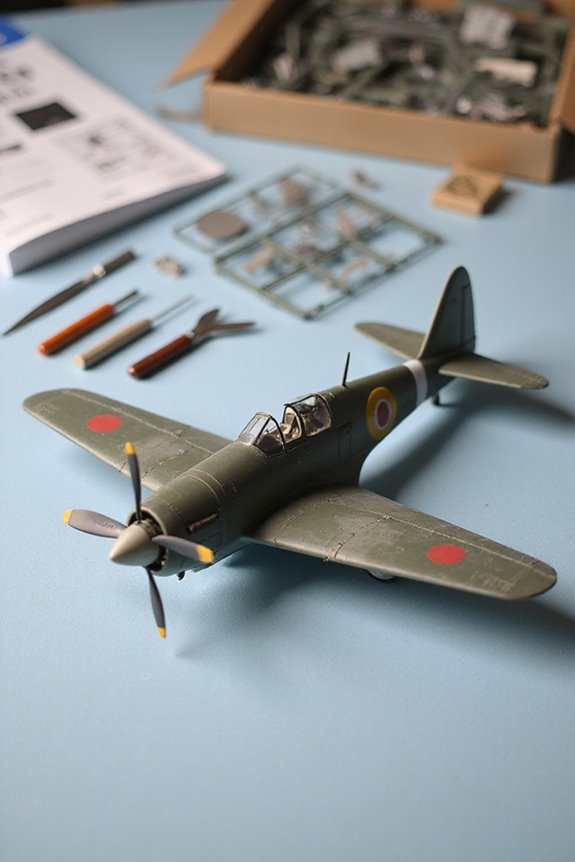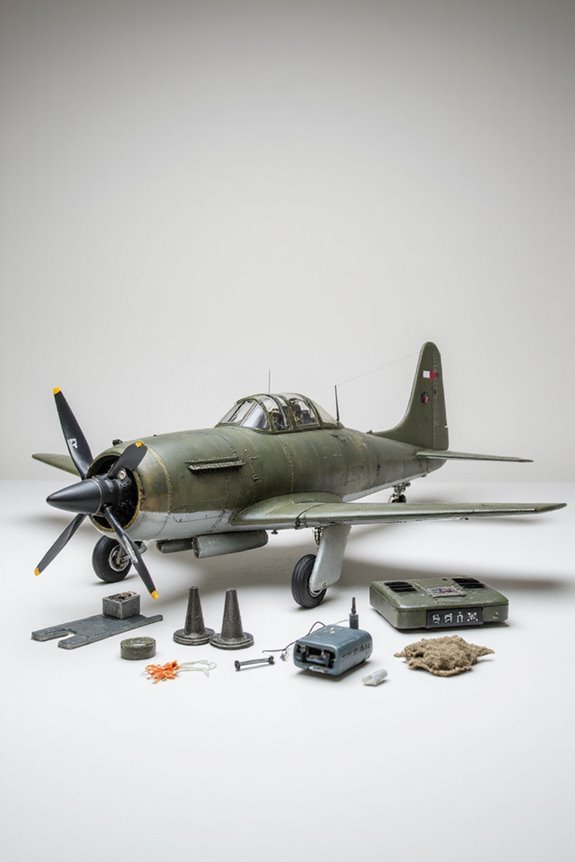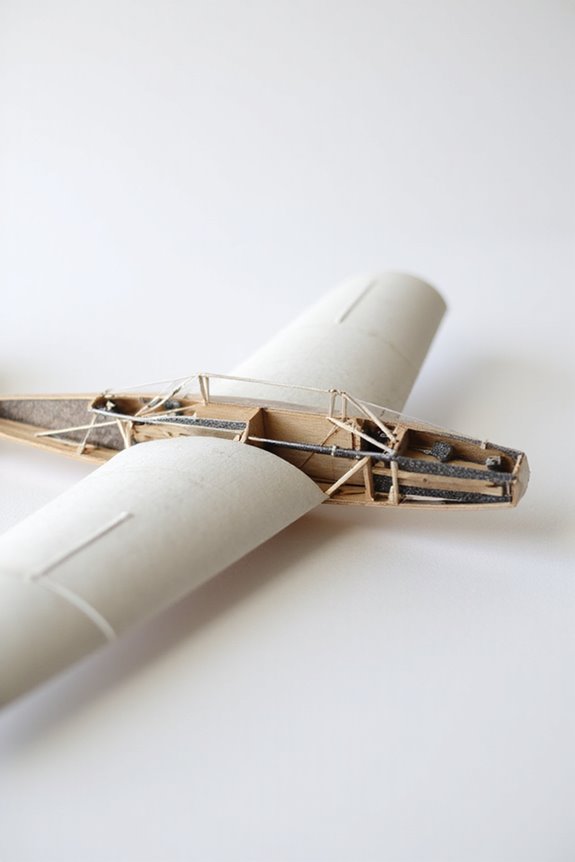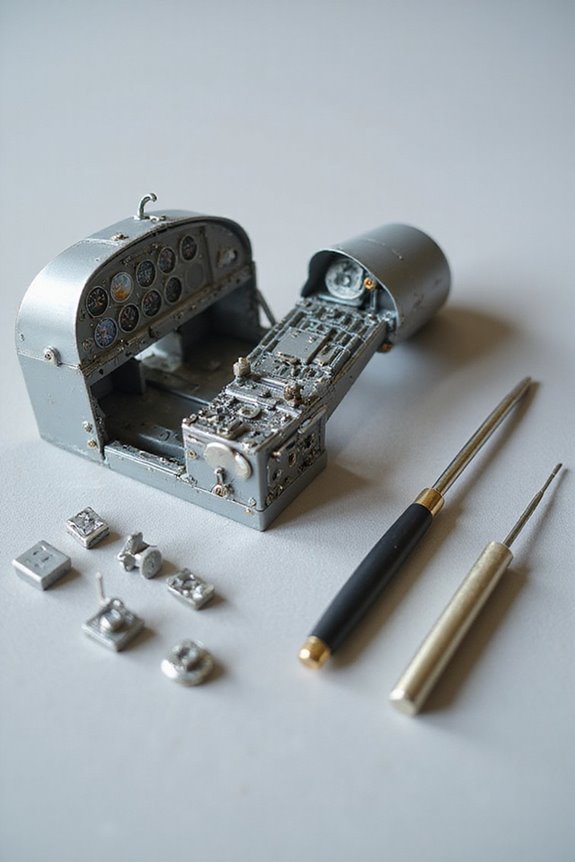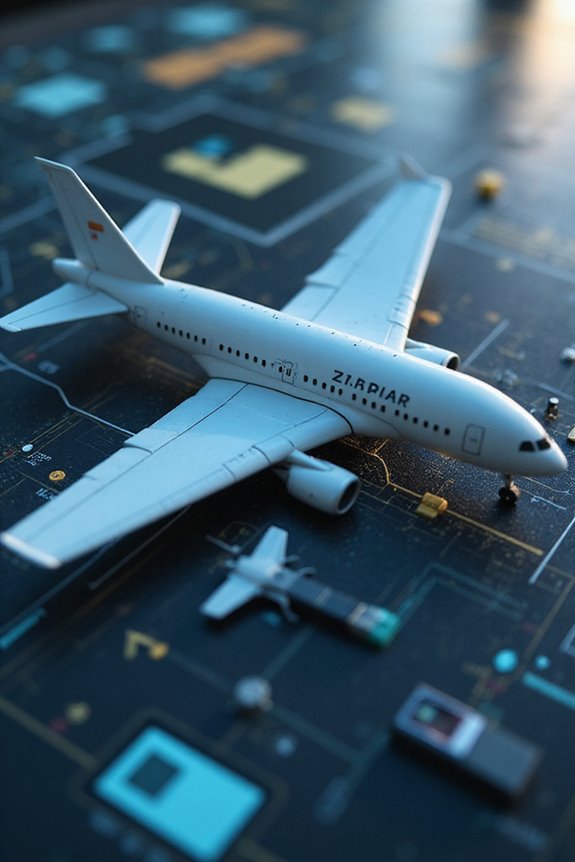When we’re building model aircraft, having the right tools is essential for success. We need precision cutting tools like hobby knives and razor saws for clean cuts. Measuring tools, such as digital calipers and steel rulers, help us guarantee everything fits together nicely. A solid adhesive like CA glue is perfect for quick bonds, while an airbrush gives us that smooth paint finish we all crave. Stick around, and we’ll uncover even more tips for your model-building journey!
Key Takeaways
- Essential cutting tools, like hobby knives and razor saws, ensure precision and cleanliness in shaping and detailing aircraft components.
- Measuring tools such as digital calipers, steel rulers, and profile gauges are vital for accurate dimensions and precise assembly.
- A variety of adhesives, including CA glue and epoxy, is crucial for securing aircraft parts under varying stress and flexibility requirements.
- Painting tools, such as airbrushes and good paint brushes, are necessary for applying a smooth finish and detailing to model aircraft.
- Clamping tools and custom jigs are important for ensuring parts are held securely in place during gluing and assembly to maintain alignment.
Essential Cutting Tools
When it comes to model aircraft building, having the right cutting tools is essential, and we can’t stress that enough. Think of hobby knives as our best friends—they provide precision with interchangeable blades for any shape or contour. Then we’ve got razor saws, which are like the muscle of our toolkit, making clean cuts in thicker materials.
Don’t forget about scissors and shears for trimming decals or those pesky sprue gates. And what’s a cutting session without cutting mats? They protect our workspace and keep our blades sharp. Finally, files and rasps help us smooth edges for a clean finish. With these tools, we’re ready to tackle any model project! Engaging with model airplane kits promotes STEM learning related to flight dynamics and critical thinking skills. Let’s cut to the chase and get crafting!
Measuring and Tracing Tools
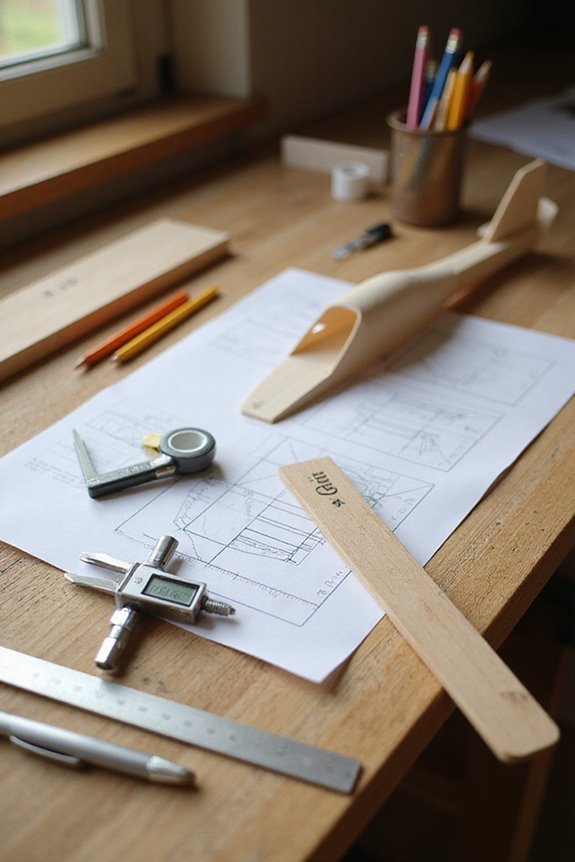
While we might think of cutting tools as the heroes in model aircraft building, measuring and tracing tools are definitely the unsung sidekicks that help us stay on track. Digital calipers offer remarkable measurement accuracy, making them perfect for tiny model details. Steel rulers and tape measures assist us in determining lengths effortlessly.
For tracing, mechanical pencils and profile gauges let us transfer measurements directly with precision. Remember, proper tool maintenance is essential. We should clean our tools after each use and store them safely to avoid bending or damage. After all, a well-kept ruler is a happy ruler! Accurate measurements not only improve our models’ looks but also guarantee they’re structurally sound enough for flight.
Adhesives and Fasteners
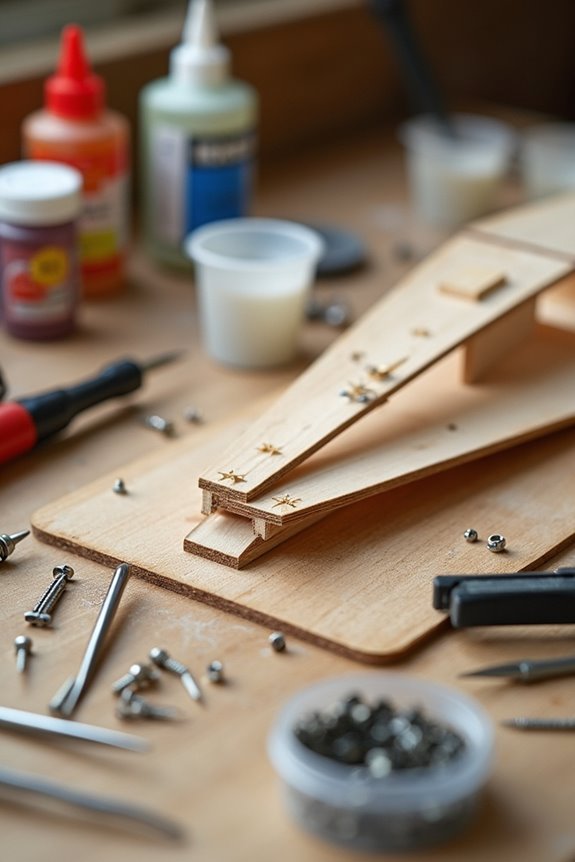
Adhesives and fasteners are the unsung heroes that hold our model aircraft together. Without them, our beautiful creations would probably fall apart mid-flight, and we wouldn’t want that! When it comes to adhesive types, we often reach for cyanoacrylate (CA) glue for its quick bonding or epoxy for those high-stress joints. Yellow woodworker’s glue is great for flexibility, and hot glue is perfect for fast foam assemblies.
For fastener selection, screws work wonders on heavier parts, while pins can temporarily hold components in place during gluing. Always consider the weight and alignment when using fasteners—no one wants a wonky wing! Choosing the right adhesive and fastener is like picking the perfect seatbelt; it keeps everything secure and safe in the air.
Painting and Finishing Tools
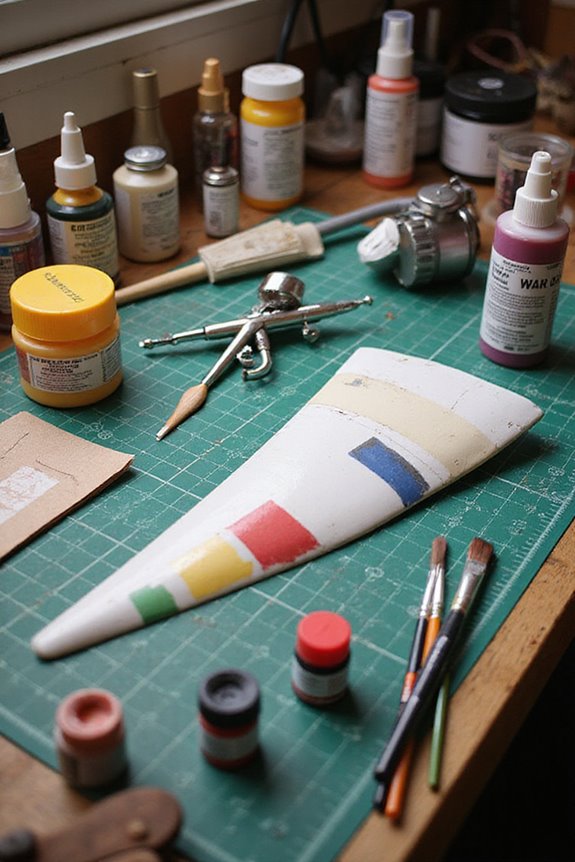
Getting the right tools for painting can make a world of difference in our model aircraft projects. For smooth paint application, we should consider using airbrushes. They’re fantastic for achieving even coats and can make our models look professionally finished.
For those detailed touch-ups, a good set of paint brushes is a must! Don’t forget paint strainers; they help keep our paint free of debris, ensuring that every coat looks impeccable.
Surface preparation is essential, too. Applying primer before painting makes a world of difference in how the final colors appear. Finally, using clear coats seals everything beautifully, so our hard work stands the test of time. Let’s gear up and make our models shine!
Clamping and Alignment Tools
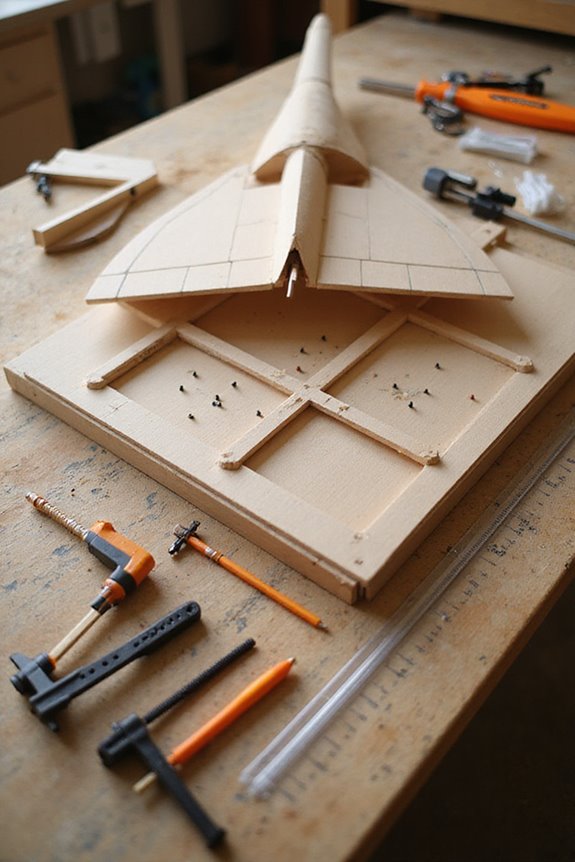
After we’ve prepped our models with the perfect paint job, it’s time to focus on keeping everything in line—literally. Clamps are absolutely essential for holding our model parts in place while glue dries. Using different clamp types like nylon grip clamps and G-clamps helps us manage various challenges, especially with intricate or heavier pieces.
Now, let’s talk alignment techniques. Steel rulers and alignment devices come into play, ensuring our parts sit straight and true. Custom jigs are a game-changer for precise angles, while adjustable clamps work wonders on various sizes. With these tools, our models won’t just look good; they’ll perform great too! After all, who wants a model that’s as crooked as a crooked smile? Happy building!
Power and Specialized Tools
When it comes to model aircraft building, having the right power and specialized tools can make all the difference. Our power tool selection is essential, with drills and drill presses for precise holes, and Dremels for every little detail. We can’t forget disk sanders for smoothing surfaces or scroll saws for those tricky curves.
Specialized tool benefits, like X-Acto knives for precision or hacksaws for clean cuts, can elevate our work. Think of them as our trusty sidekicks! Plus, tools like countersink cages and rivet dimple dies help us achieve that perfect finish. With these gear essentials, we’ll take our model-making skills to new heights – and maybe even avoid a few mishaps along the way! Additionally, understanding assembly difficulty levels can guide us in selecting the right tools for our projects.
Safety Equipment and Organization
Safety equipment is our first line of defense in model aircraft building. We can’t achieve our flying dreams if we lose an eye to a rogue glue bottle! Always wear goggles when working with adhesives and paints. Gloves are useful too, but let’s not wear boxing gloves when handling tiny tools.
To keep things safe, let’s adopt good safety practices and maintain workspace cleanliness. A clutter-free bench not only helps us focus but prevents accidents—nobody likes tripping over stray model parts!
Also, check tools before use; they shouldn’t look like they’ve been through a battle. Proper ventilation is key to avoiding those back-from-the-dead paint fume headaches. With the right gear and a tidy space, we can build with confidence!
Frequently Asked Questions
What Is the Best Beginner Model Aircraft to Start With?
When we think of soaring dreams, choosing a beginner aircraft like the Tamiya F4U-1D Corsair brings excitement. With simple designs and helpful tips, we can embrace various aircraft types and nurture our passion together.
How Do I Choose the Right Scale for My Model?
When we’re considering scale selection, we should align our model preferences with available space and budget. Smaller scales are great for tight spaces, while larger ones offer stunning detail for those who can accommodate them.
What Materials Are Commonly Used in Model Aircraft Building?
Just as a bird soars with the right feathers, our models thrive on materials like balsa wood and various adhesive types. These essentials offer us the foundation to create masterpieces in model aircraft building.
How Can I Improve My Painting Techniques for Models?
To improve our painting techniques for models, we should explore different paint types and practice brush techniques, like layering and drybrushing. Experimenting will lead to more realistic finishes and greater satisfaction in our work.
Where Can I Find Model Building Communities or Clubs?
In the tapestry of model building, we weave connections through online forums and local clubs. Together, we share tips, showcase our creations, and ignite our passion, making every project an adventure worth exploring.

